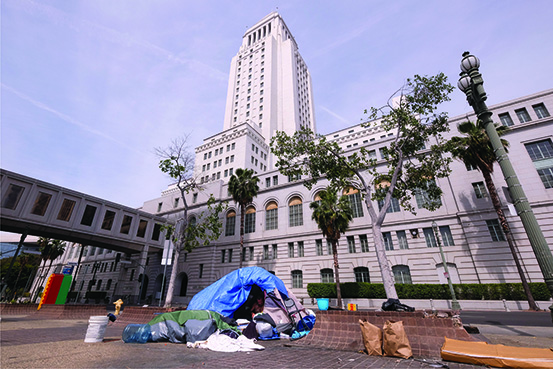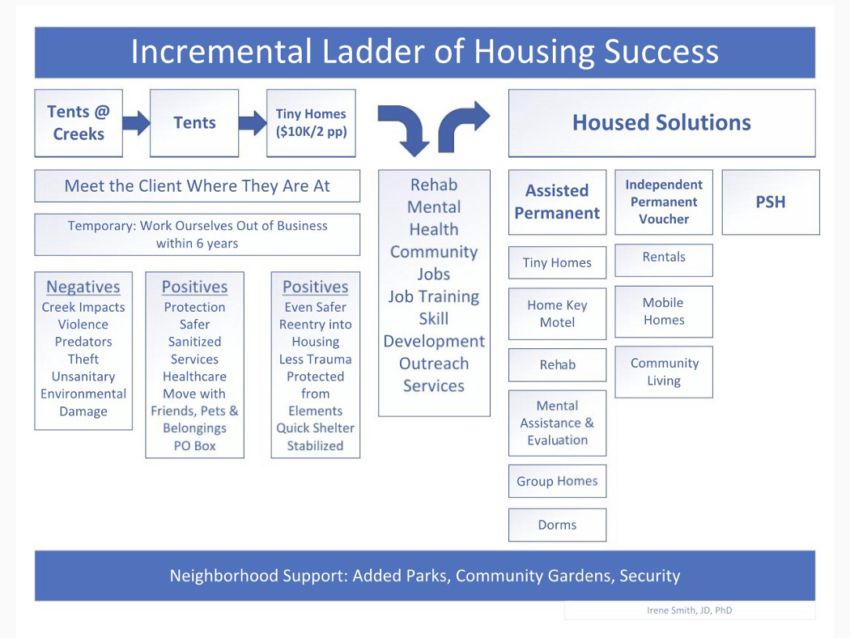The Unhoused and the Law

Why do West Coast cities seem so incapable of dealing with the homelessness crisis?
By Irene Smith, JD, PhD, San Jose Area Rental Housing Provider
It’s easy to blame government incompetence, but there’s something even more fundamental at work: Martin vs.Boise,e a landmark case from the 9th Circuit Court of Appeals. That’s a 2019 legal decision that ruled homelessness is not a crime and that unless shelter is provided, people may sleep in public spaces. Worthy sentiments, to be sure. It certainly should not be a crime to be homeless.
San Jose does not have enough shelter for every unhoused person. [Editor’s Note: Nor do any other West Coast cities and counties.] So, unhoused persons live in parks and along creek sides and the City uses re-traumatizing abatements to clean encampments instead of offering quick shelter.
But Boise’s unintended consequence left the door wide open for any number of illegal behaviors to occur by individuals who are homeless: illegal fires, illegal encampments, illegal dumping, illegal public defecation and urination, illegal trespassing, illegal destruction of personal property, illegal entry into homes (a neighbor once found someone sleeping in their laundry room), illegal threatening behavior and outbursts in personal space, illegal use of drugs in public, illegal stopping and hampering traffic flow, creation of public health hazards and environmental damage, etc., etc.
The public wonders why these types of infractions are enforced only against those who are housed. The reason is Martin vs. Boise. Until we provide a bed for each unhoused person, we will not be able to fully enforce all our laws equally for each person who lives in San Jose. [Editor’s Note: Nor in any other of our West Coast cities and counties.] So, the answer is simple. We must provide a bed for each unhoused person. It does not need to cost one million dollars per door. It does not even need to have a traditional roof. What it does need is to provide shelter under the law.
And, to my way of thinking, this needs to go further: we should provide shelter-stabilization, security, showers, safety, a post office box, mental health services and rehabilitation services. All this can be done while waiting for other housing options and for permanent housing to be built. Shelter-stabilization is more than a bed and more than a night-shelter that routinely asks everyone to leave [in the morning]. This shelter, stabilizes the unhoused client with a reliable bed and dependable services.
But allowing humans to suffer, live and die on sidewalks, creek sides, and playgrounds is inhumane and completely unnecessary. So is allowing a lawless subculture to perpetuate itself in and around our neighborhoods. My solution, the “Incremental Ladder of Housing Success,” can be implemented today. We can help people today. We can immediately stop people from dying alone on the creek sides. And we can enforce our laws so that everyone is safe.
Incremental Ladder of Housing Success

At this moment in time, we have spent nearly one billion dollars on affordable housing [Editor’s Note: Statewide, this figure is far greater.] and what we see on our creeks and rivers [freeway underpasses, sidewalks, entryways, etc.] is a substantial increase in human suffering living outdoors in haphazard tents and cardboard coverings. Exposed to the elements, predators, infestations, disease, and denied the simplest of comforts, we wait for housing to be built. And when permanent, supportive housing is built, it is built at an average cost of $850,000 per door.
On 21st Street and Santa Clara [in San Jose] we are now building one million dollars per door! The per door cost is a fixed cost. The variable costs will add up to far more in the long run especially if we do not house people appropriately. These variable ongoing costs include the expenses of property management staff and services, maintenance and repairs of the building, lease, utilities, and the necessary and exceptional services that must accompany the residents in order to make both the building and the surrounding neighborhoods successful.
Housing options seem to be a one-off collection that may or may not include the services needed for each individual client. There is no straight line of success for housing, and no plan of advancement through a confusing system. In fact, someone who is unhoused hardly knows where to begin asking questions such as “how to do I start the process?” (when there isn’t one) and most importantly — “how will I know when I am successful?”
In visiting and exploring two downtown [San Jose, California], permanent supportive housing locations, I am reminded that often the residents don’t stay in their rooms. They leave at night to sleep outside because it’s too quiet. They sleep on the floor because the bed is not comfortable. Sensors must be installed to remind residents not to move too far away from the stove while it is on. And a fire fighter mentioned to me that a resident was pushing a grocery cart through the hallway while it was on fire. Moving directly from a tent to an $850,000 apartment can re-traumatize a resident and exacerbate post-traumatic stress syndrome (PTSD). In addition, acclimating them to their new surroundings takes time and planned adaptation. We need a better transition plan.
All this while we wait and hope for the building. What is missing is an “Incremental Ladder of Housing Success.” Instead of waiting years for more structures to be built, how could we even ever so slightly improve the conditions of the people we see who are suffering while living on the streets? In psychology there’s a saying we use about meeting the client where they’re at. Attempting to skip the therapeutic process and immediately get to the end result leads to unexpected results such as defiance, anger, depression, and confusion on the part of the client. The same can be true for someone who has lived on the streets, perhaps in a tent, for many years and is immediately brought into an apartment with four walls, a bed, appliances, and rental contract rules.
Why not meet the client where they’re at? If we can incrementally make their lives just a little bit better, why not? Why wait years for buildings, if we can act right now and make their environment incrementally better?
PHASE I — Bridge Shelters and Tiny Homes on County and City Land
If our homeless clients are living in tents, let’s meet them where they’re at. Let’s ask them to move in their tents, in their communities, with their pets to one or three destination locations of the city or the counties preference. Those locations will offer better protection for the client than sliding down a creek bed and they will be protected from predators. We can stop the constant fires and the degradation to the environment on the waterways that go to the Bay. We can stop the infestation. We can provide post office boxes, showers, safety, and allow the nonprofit organizations and churches to find their clients in one location. This approach will make it easier for city services, county services, and nonprofit services to reach clients immediately, where they are at.
Are bridge shelter tents a permanent solution? No. It is a way to improve their quality of life incrementally and immediately. But tents are one rung on the ladder. The next step on the ladder is to gradually move unhoused individuals from tents into temporary tiny homes at the previously chosen locations. They are temporary because we don’t expect folks to stay at these locations forever. We expect to be able to work our way out of business within six years and house people in permanent locations.
Arnold Schwarzenegger recently purchased 25 tiny homes in Los Angeles for $10,000 apiece and they fit two people. We can reuse these tiny homes later once we have worked ourselves out of business. The next rung on the Ladder is a variety of wrap-around services once residents have become stabilized with housing. Services will include rehabilitation, mental health support, community jobs, and job training.
PHASE II — Permanent: Assisted or Independent Voucher
The next transition on the Ladder will choose between assisted permanent housing or independent permanent housing with San Jose rental vouchers. A quick comment on vouchers. We have nonprofit organizations that offer temporary, short-term vouchers for rental assistance. We also have a wonderful [U.S. Housing and Urban Development Department] program called Section 8 from the federal government which assists with rental payments. The Section 8 program is cumbersome and burdensome for both the applicant and the housing provider and the most challenging part of Section 8 is the incredibly long wait time to be approved as an applicant. San Jose can do better, and we can provide our own rental voucher program and stop waiting for Section 8 to help.
The assisted permanent housing will include a wide variety of choices. Tiny homes, home key motels, rehabilitation, mental health assistance and evaluation, group homes, dormitory-style, and community living. This assisted permanent housing will have wraparound services and use the housing models we already have in place. Or unhoused persons will be assigned to independent permanent housing using the San Jose rental voucher program. They will be able to choose between rentals, mobile home parks, tiny homes, community living, and other options at their choosing.
And of course, the final rung on the Ladder will be the permanent supportive housing (PSH) and we can help developers manage their costs, because if we do indeed have 10,000 unhoused people in Santa Clara County we will not be able to fund an $850,000 door per person. Housing stabilization is critical, and we must have the services to support the residents. And in supporting the residence we can also supporting the surrounding neighborhoods.
The Incremental Ladder of Housing Success works while we wait for more housing to be built. And in six years, when we have worked our way out of business and no one is in a tent and no one is at the temporary locations, there will be more housing because we are planning for it right now.
Irene Smith, PhD, JD has had held multiple jobs throughout her career, starting off in finance at IBM and working inside a mental health facility before getting her law degree. She then opened a mediation business and serves as a volunteer attorney with Santa Clara County’s Pro Bono Project. She also owns and manages several rental properties in San Jose. In 2022, Ms. Smith ran for City Council in San Jose.



